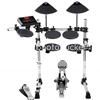
Set Up
To start, lets look at the set up of the Kit. It is basic at best, a small computer attached to one of the arms that controls the mix, sounds and has all the inputs for the triggers, five identical pads to represent the snare, toms and hi-hats. There is nothing very much out of the ordinary there except that the pad for the hi-hats is the same shape as the other bands, most of the new kits have different designs for the hi-hat pads to make it more distinguishable from the other pads, and to give it s more realistic feel. However, this does not really matter in terms of practicalities, its just a nice feature to have. The kit only comes with two cymbal pads, (Ride and Crash). The cymbal pads are as basic as the rest of the kit, hard and triangular, but they do the job. Also included is the bass drum pad (with a stand and kick pedal) and a hi-hats pedal. The kick pad is great for using a single pedal, but struggles when i double kick pedal is attached, i doubt that is was designed for double kick use but i practice with it anyway!. The hi-hat pedal has a very light feel, it doesn't feel like a really hi-hat pedal as there is little resistance or control of how you want to the hats to sound. Its pretty much just open or close, with a small about of give in-between. The whole kit is held together by what is essentially, light, plastic scaffolding. Alot of what I've said there does sound very negative. But it isnt, the kit is what you pay for. This is not an expensive kit, so by not paying much you get a basic package, but it does do the job required!
Sound
Now I think that we should address the triggered sounds that come with this kit. The computer comes with 32 different pre-programed kits, as well as space to set your own kit sounds up (something witch i haven't got around to messing around with yet). Alot of these are just for fun and are not really practical, but the sounds for the acoustic drum kits are actually pretty good. It is obviously that the sounds for these were recorded from a real drum kit in a studio, although these are not the kind of sounds I look for when going to play a gig, but for practicing this is exactly what you need. The sounds on this kit give you a realistic idea of what your playing would sound like on an acoustic kit with out reaching the volumes of an acoustic kit. This is something that is very useful, as any drummer will tell you, because as much as everyone loves playing on a real kit, it can become difficult to hear yourself, and to fine tune your playing so that everything is tight and accurate. The DTXplorer allows you to do this.
Feel
For most drummers, including myself, this is the most important thing when looking at an electronic drum kit. It just isn't the same unless you feel like you're playing a real kit. Unfortunately, you are not playing a real kit when one the Xplorer, and it is very noticeable that you aren't. The bands are firm, and offer some bounce but not loads, the cymbal bands hardly move when you hit them and certainly don't give you the satisfying feeling of smashing a live crash cymbal, and the hi-hat pedal squeaks!
But despite all this, The Xplorer was a brilliant buy. It is great for practice, using my explorer and can practice to click tracks, and use the groove check to see that I'm in time, and sort it out if im not. It takes up little space and folds down so even in my small uni room there is plenty of space for it. I can play at anytime (with in reason) because the pads are not too loud and I can plug my headphones in. The clear and controlled sounds that the triggers give allows me to clearly hear my playing so that i can tighten up my hands and feet and lock in with the groove and click track. The aux-in means that I can plag my ipod/laptop in and set the mix so that I can play along to tracks and hear myself and the track.
Budget
Most drummers reading this will argue that most electric kits can do all this and much more. Most new electronic kits do have mesh heads on now witch give a much more authentic feel, i know, ive tried them. But what i will argue to that is that they are expensive, and that the Xplorer is considerably cheaper. I guess it all depends on what you want out of it. I myself have a lovely acoustic kit that i saved up for which, to me anyway, sounds beautiful and fantastic. I uses it for recordings, gigs and rehearsal. So for me, spading loads of money on a really fancy, real feel kit with all the bells and whistles on it sounds like a waste of money. But that is not the same for everyone and it depends on you're situation and what it is you want out of the kit, it may well not just be for practice.
Bottom line
I have been playing drums for a few years now. And i need something to practice on for hours during the day, and in my house, at home and in my room at uni. My acoustic kit is only available when convenient for everyone else. So the Xplorer serves its purpose for practice only, and it is great for that. However if you need an electric kit for a band, gigs or recording then look else where.

No comments:
Post a Comment